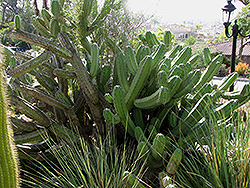Fri & Sat 8am - 8pm
Sun 8am - 7pm
Anytown, USA 12345
fax: 261.787.0463
e-mail: info@successgc.com


Plant Finder

Height: 15 feet
Spread: 7 feet
Sunlight:
![]()
![]()
Hardiness Zone: 8b
Other Names: Blue Myrtle-cactus
Description:
An upright, columnar cactus that becomes tree-like with age, resembling a candelabra; features thick, cylindrical gray-green to blue stems; white to red flowers in spring, followed by edible dark red or blue fruits; an outstanding vertical accent
Ornamental Features
Blue Candle is a member of the cactus family, which are grown primarily for their characteristic shapes, their interesting features and textures, and their high tolerance for hot, dry growing environments. Like all cacti, it doesn't actually have leaves, but rather modified succulent stems that comprise the bulk of the plant, and which are designed to hold water for long periods of time. This particular cactus is valued for its upright and spreading habit of growth which can occur as either a single spiny ribbed bluish-green stem or grow as a cluster of such stems that spread out from a central base. This plant features showy creamy white daisy flowers with buttery yellow eyes along the branches from mid winter to early spring, which emerge from distinctive brick red flower buds. It features an abundance of magnificent silvery blue berries from late spring to early summer.
This plant is primarily grown as an ornamental, but it's also valued for its edible qualities. The small round sweet fruit is most often used in the following ways:
- Fresh Eating
- Preserves
Landscape Attributes
Blue Candle is a large succulent evergreen plant with an upright spreading habit of growth. It tends to form a colony of solitary stems that spread out and away from the base. As a type of cactus, it has no true foliage; the body of the plant is wholly comprised of one or more spiny bluish-green stems which are prominently ribbed. With age, this plant will eventually develop a woody khaki (brownish-green) 'trunk' at its base.
This is a relatively low maintenance plant, and should never be pruned except to remove any dieback, as it tends not to take pruning well. However, secondary stems may be carefully removed at the base to control the spread of the plant. It is a good choice for attracting birds to your yard, but is not particularly attractive to deer who tend to leave it alone in favor of tastier treats. Gardeners should be aware of the following characteristic(s) that may warrant special consideration;
- Insects
- Spiny
Blue Candle is recommended for the following landscape applications;
- Accent
- Vertical Accent
- Hedges/Screening
- General Garden Use
- Container Planting
Planting & Growing
Blue Candle will grow to be about 15 feet tall at maturity, with a spread of 7 feet. It is often either grown as a solitary specimen or permitted to grow into a broader colony as part of a garden composition. It grows at a medium rate, and under ideal conditions can be expected to live for 80 years or more.
This plant does best in full sun to partial shade. It requires an extremely dry, well-drained growing location, and will usually die in standing water. It is considered to be drought-tolerant, and thus makes an ideal choice for a low-water garden or xeriscape application. Like most succulents and cacti, this plant prefers to grow in poor soils and should therefore never be fertilized. It is not particular as to soil pH, but grows best in sandy soils. It is somewhat tolerant of urban pollution. This species is not originally from North America.
Blue Candle is a fine choice for the garden, but it is also a good selection for planting in outdoor pots and containers. Its large size and upright habit of growth lend it for use as a solitary accent, or in a composition surrounded by smaller plants around the base and those that spill over the edges. It is even sizeable enough that it can be grown alone in a suitable container. Note that when growing plants in outdoor containers and baskets, they may require more frequent waterings than they would in the yard or garden.
